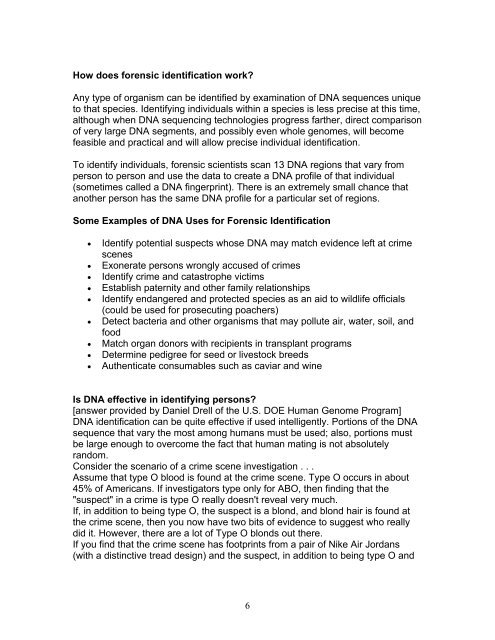Investigating CSI – Background material Table of Contents I ...
Investigating CSI – Background material Table of Contents I ...
Investigating CSI – Background material Table of Contents I ...
Create successful ePaper yourself
Turn your PDF publications into a flip-book with our unique Google optimized e-Paper software.
How does forensic identification work?<br />
Any type <strong>of</strong> organism can be identified by examination <strong>of</strong> DNA sequences unique<br />
to that species. Identifying individuals within a species is less precise at this time,<br />
although when DNA sequencing technologies progress farther, direct comparison<br />
<strong>of</strong> very large DNA segments, and possibly even whole genomes, will become<br />
feasible and practical and will allow precise individual identification.<br />
To identify individuals, forensic scientists scan 13 DNA regions that vary from<br />
person to person and use the data to create a DNA pr<strong>of</strong>ile <strong>of</strong> that individual<br />
(sometimes called a DNA fingerprint). There is an extremely small chance that<br />
another person has the same DNA pr<strong>of</strong>ile for a particular set <strong>of</strong> regions.<br />
Some Examples <strong>of</strong> DNA Uses for Forensic Identification<br />
• Identify potential suspects whose DNA may match evidence left at crime<br />
scenes<br />
• Exonerate persons wrongly accused <strong>of</strong> crimes<br />
• Identify crime and catastrophe victims<br />
• Establish paternity and other family relationships<br />
• Identify endangered and protected species as an aid to wildlife <strong>of</strong>ficials<br />
(could be used for prosecuting poachers)<br />
• Detect bacteria and other organisms that may pollute air, water, soil, and<br />
food<br />
• Match organ donors with recipients in transplant programs<br />
• Determine pedigree for seed or livestock breeds<br />
• Authenticate consumables such as caviar and wine<br />
Is DNA effective in identifying persons?<br />
[answer provided by Daniel Drell <strong>of</strong> the U.S. DOE Human Genome Program]<br />
DNA identification can be quite effective if used intelligently. Portions <strong>of</strong> the DNA<br />
sequence that vary the most among humans must be used; also, portions must<br />
be large enough to overcome the fact that human mating is not absolutely<br />
random.<br />
Consider the scenario <strong>of</strong> a crime scene investigation . . .<br />
Assume that type O blood is found at the crime scene. Type O occurs in about<br />
45% <strong>of</strong> Americans. If investigators type only for ABO, then finding that the<br />
"suspect" in a crime is type O really doesn't reveal very much.<br />
If, in addition to being type O, the suspect is a blond, and blond hair is found at<br />
the crime scene, then you now have two bits <strong>of</strong> evidence to suggest who really<br />
did it. However, there are a lot <strong>of</strong> Type O blonds out there.<br />
If you find that the crime scene has footprints from a pair <strong>of</strong> Nike Air Jordans<br />
(with a distinctive tread design) and the suspect, in addition to being type O and<br />
6


